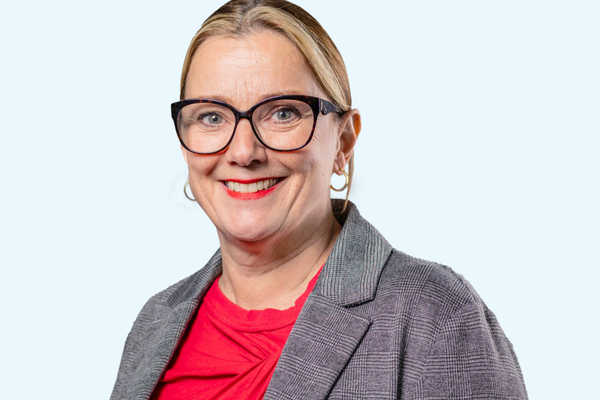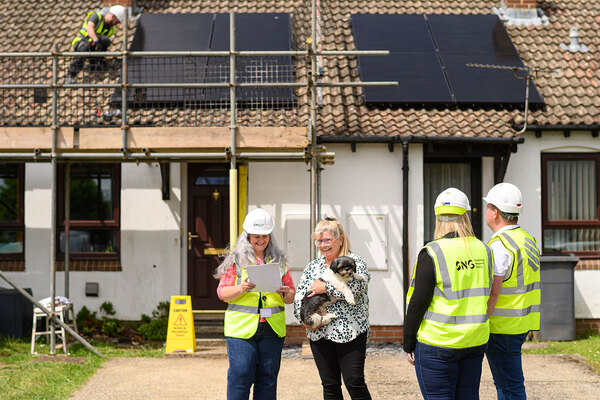What will Awaab’s Law mean for landlords and residents?
An Inside Housing roundtable, in association with Switchee, discusses how incoming legislation will affect how landlords approach repairs and maintenance in their homes. Photography by Belinda Lawley
In association with:
![]()
The death of two-year-old Awaab Ishak in 2020 has prompted new legislation as part of the Social Housing (Regulation) Act 2023. Under the act, social landlords will be required to investigate and fix hazards within strict timeframes.
While social landlords welcome the intent of the law, many still face internal and external challenges to comply with it. Questions also remain around skills, supply chain, resources and data management.
To discuss these issues and potential solutions, Inside Housing invited leaders from housing associations of all sizes to a roundtable discussion, chaired by editor Martin Hilditch. The event is hosted in association with Switchee, a technology company providing real-time, data-driven insights for social housing providers.
Challenges to compliance
Most around the table agree on the key challenges housing associations face to comply with Awaab’s Law. One is the supply chain and recruitment and retention in the sector – Inside Housing’s annual Risk Register survey revealed that recruitment and retention has been identified as a top five strategic risk. Greg Birch, director of assets and compliance at St Mungo’s, a homelessness charity with 350 properties, says: “We’re still struggling to get good, qualified staff and… good contractors.”
While many around the table state their organisations have robust processes to deal with damp and mould, the fact that the scope of Awaab’s Law includes all 29 hazards in the Housing Health and Safety Rating System could mean significant new reporting requirements.
“What it means is that we’ll need to inspect many more properties than we do currently to err on the side of caution,” says David Lewis, executive group director of property services at 109,000-home L&Q. “And there are just real challenges around supply chain and capacity, both in-house… and externally.”
The discussions also highlight the work that still needs to be done around hazard reporting and how landlords manage (and act upon) data. The legislation sets timelines, but Steve Lowther, head of property maintenance at 29,000-home Gentoo Group, illustrates how difficult it can be to report urgent hazards within 48 hours, for example. “That’s not working days – that’s hours,” he says. “So for instance, if you carry out a damp survey on a Friday, the expectation is that the report is with the customer on Sunday.”
James Reseigh, director of neighbourhoods at 40,000-home LiveWest, agrees. He and colleagues have estimated the cost of generating reports to be around £600,000. “When you look at those 29 hazards, it’s really hard to produce a report that can be automated,” he says.
Given the breadth of hazards covered in the legislation, Ian Gregg, executive director of asset services at 80,000-home Riverside, thinks that the focus of the new law should firmly be on damp and mould, and that the problem should be addressed across the UK’s housing stock, not just the social sector.
Delegates are keen to stress that the new regulation is one of many that landlords have had to deal with in the past few years. Anita Khan, chief executive of 3,000-home Tower Hamlets Community Housing (THCH), wonders how housing associations would have acted differently if all these changes had been delivered as one package. “Because it’s an ‘and, and, and,’ it feels like we’re incrementally trying to adapt as opposed to inherently rethinking our operating and financial models to respond to the operating environment that we’re now existing in,” she says.
The discussion around damp and mould remediation often centres around repair, but many at the table want to put this into the context of long-term improvements to homes. They acknowledge, however, that the business case for such an approach can be difficult.
Tom Robins, chief executive of Switchee, has some reservations about the implications of the law. “We’ve been passionate for a long time about moving the sector from being reactive to being proactive,” he says. “What we see with this legislation coming in is we’re baking in a level of reactive that’s going to take time and resources away from being proactive.”
Of course, tackling damp and mould – whether reactively or proactively – incurs costs. And when it comes to this investment, Patrick Chauvin, chief officer for safety, assets and sustainability at 39,000-home Stonewater, suggests that capital investment might be a better solution. “It seems to me that everyone is going to be channelling money into revenue spend, when probably the solution is the opposite to that.”
Carol Carter, chief executive of 7,800-home Origin Housing, is concerned that recent regulation tends to address symptoms. “Those symptoms are about the constraints across the sector around investing in homes.”
Alongside the sector’s goals to build more affordable homes, there should be, in parallel, a long-term plan for the quality of housing as well. Ms Carter says: “There’s a real opportunity there, particularly potentially with
a new government, to take that proactive approach… We’re all prepared to invest here, but let’s do it in a planned and measured way. And try to avoid a situation with layer upon layer of new expectations and new regulation. Because that’s just exacerbating the problem and diverting cash away from what it needs to be spent on, which is long-term investment.”
Anita Jones, chief executive at 6,700-home Freebridge Community Housing, believes that associations have a solid track record of handling unexpected change in the form of new regulation or legislation, but there should be a balance. “We all say to our boards that we are long-term businesses, and only a small proportion of our day-to-day activity should be on the crisis – however important that is – for long-term sustainable planning.”
Many participants at the roundtable highlight collaboration as an area for improvement. Not only can it help improve the sharing of information and best practice, but housing associations can also benefit from better procurement, and have easier access to shared services or supply chain partners.
Collaboration is key
Tim Weightman, chief investment officer at 75,000-home Places for People, believes “the sector talks a good game about collaboration but then falls short”. “Everybody has at least one good idea that they’ve never shared with anybody else. If we got that on the table, that’s massively powerful,” he adds.
As one example, Mr Weightman highlights the work done by the Future Homes Consortium. Around 20 landlords have been sharing data on how repair demand has evolved year on year, resulting in a clear picture across a large sample of homes. However, the group has found it more difficult to sign up to joint action. “There has to be a real call to action,” he says. “Sharing knowledge and expertise is quick and easy. Signing up to a procurement deal with other people is hard.”
Riverside is part of the Greater Manchester Housing Partnership. Mr Gregg notes that this collaboration works particularly well because of the historic close links between the 10 local authorities in the city region and the tripartite nature of the partnership, which includes housing, local government and healthcare.
“We’re happy to share data,” he says. “But there are also calls to action, whether that be about addressing homelessness or building new homes and our part to play. Damp and mould was a natural subset of that.”
If landlords are to investigate and resolve hazards promptly, panellists agree that the sector needs more skilled people. This has been an issue for a long time. But L&Q’s Mr Lewis puts the problem in stark terms: “The average age of a gas engineer is 57,” he says. “In our repairs service, the average age is 50. There are big issues around attracting young people into the sector.”
“Lots of people talk about what they’re doing in their own business around social value and attracting apprentices, but they’re not sharing… Unless we collaborate and have a programme of talking up the sector and attracting new, young people, we just won’t be able to deliver our development and investment plans that we’ve committed to.”
The panel agrees that there is scope for landlords to work together to share resources, especially between larger and smaller organisations. Technical specialists could become a shared local resource for the sector, given that many different landlords may operate in the same area. Ms Khan at THCH gives an example of how this model could work: “We have probably got properties that are right next door [to L&Q properties]… so if the resource is there for the sector, [a] surveyor is going to block A, why could they not come next door and see our property as well?”
There is also widespread agreement that selling the sector to young people means telling a better story about the societal value of social housing and what it means to local communities. Ms Jones has noticed an influx of new, purpose-driven employees who want to put something back into the area they grew up in. “Most of our recruitment has been of very skilled people coming back to the local area… Something like 50% of the people who work for Freebridge now… don’t come from a housing background,” she explains.
Many participants raise concerns about the difficulty of managing and reporting on data about hazards. But Mr Robins reinforces how important that data can be in addressing the damp and mould issue. Many residents, he notes, will not complain or do not perceive a problem, and the law is based around residents raising concerns. “If we base [our response] just on complaints, particularly in the worst cases, there is a silent group of people that are not going to get served,” he says.
Mr Chauvin is keen that landlords look at a holistic data picture here, correlating hazards with resident vulnerability, although he recognises this is not easy. “We focus on the assets, the homes, because we own them,” he says. “But the biggest part of the equation here is the residents. And all residents are individual.”
Data can also unlock more insight around damp and mould and the root causes behind it. Mr Lowther points out that Gentoo sees a correlation between deprivation and damp and mould, adding that landlords have “a moral obligation, as per the Housing Ombudsman’s Spotlight report, to ‘find their silences’” in cases where residents do not raise issues.
Participants
Martin Hilditch (chair)
Editor, Inside Housing
Greg Birch
Director of assets and compliance, St Mungo’s
Carol Carter
Chief executive officer, Origin Housing
Patrick Chauvin
Chief officer for safety, assets and sustainability, Stonewater
Ian Gregg
Executive director of asset services, Riverside
Anita Jones
Chief executive, Freebridge Community Housing
Anita Khan
Chief executive, Tower Hamlets Community Housing
David Lewis
Executive group director of property services, L&Q
Steve Lowther
Head of property maintenance, Gentoo Group
James Reseigh
Director of neighbourhoods, LiveWest
Tom Robins
Chief executive, Switchee
Tim Weightman
Chief investment officer, Places for People; non-executive director, Rochdale Boroughwide Housing (joined in May 2023)
Recent content in association with Switchee
How can social landlords use data to tackle fuel poverty?
As we enter winter and fuel bills spike, half of social tenants cannot afford to heat their homes, but identifying who those tenants are remains a challenge. Here, sector leaders discuss how better use of data could fight energy poverty
UK fuel poverty: a cool summer affects results
In the fourth Housing Fuel Poverty Index update of 2024, Inside Housing looks at the numbers reported by Switchee’s smart thermostats to help track fuel poverty across the UK
CPD webinar on demand: how can social landlords assess whether retrofit is delivering intended performance improvements?
As part of Inside Housing’s CPD offering, watch the full webinar and earn CPD minutes
What do the latest fuel poverty stats tell us?
In the third Housing Fuel Poverty Index update of 2024, Inside Housing looks at the numbers reported by Switchee’s smart thermostats to help track fuel poverty across the UK
CPD module: how to approach decarbonisation policy and strategies
The policy environment on decarbonisation and retrofit is evolving, so how can social landlords continue to build strategies to meet net zero? Richard Ellis, director of sustainability at Peabody, explains in this CPD module
What will Awaab’s Law mean for landlords and residents?
An Inside Housing roundtable, in association with Switchee, discusses how incoming legislation will affect how landlords approach repairs and maintenance in their homes
Using data to deliver better services
How are landlords collecting data and using it to make decisions about asset management and meeting residents’ needs? An Inside Housing survey, with data analytics firm Switchee, finds out
Is fuel poverty on the decline?
The latest data from smart thermostat provider Switchee suggests that the fuel poverty crisis may be starting to ease. Inside Housing analyses the figures
The numbers behind fuel poverty in the UK
Switchee’s new model shows the number of social households underheating their homes across the UK in real time, during 2022 and 2023. Inside Housing looks into the figures
How can landlords help residents to save on energy bills?
Inside Housing speaks to Emma Bitting at Switchee to find out what residents can do to ensure their homes are warm, and how they can save money on bills
How landlords are using data to tackle fuel poverty
An Inside Housing roundtable, in association with Switchee, discusses how landlords can analyse data to ensure they are helping residents who are struggling with energy costs
Internet of Things devices start to make a difference
A national network of vetted installers means the industry can collaborate to provide landlords with invaluable insights, says Philip Taylor of Internet of Things device provider Switchee
Choosing smart data and tech can help landlords achieve Better Social Housing Review goals
Technology can help landlords in terms of their business and regulatory compliance, as well as improving residents’ quality of life and bringing down bills, explains Tom Robins of tech firm Switchee
















